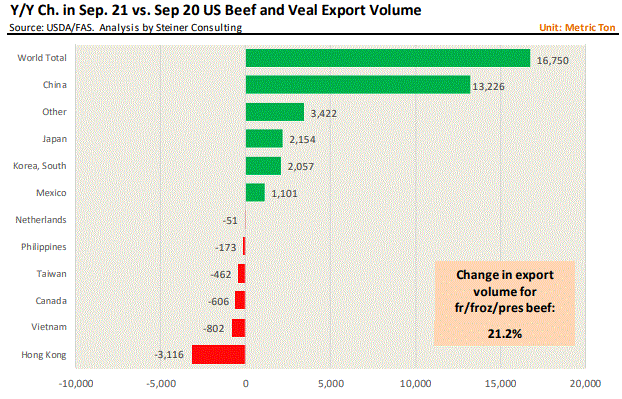Beef exports for September were higher than expected. USDA reported that total shipments of fresh/frozen and cooked beef for the month were 95,732 MT, 16,749 MT or 21.2% higher than the previous year. Weekly exports of beef muscle cuts were only 8% higher than last year, hence us saying that exports were above expectations. What stands out in the chart to the right is the impact that China has had on the y/y increase in US beef exports.
Shipments to the Chinese market were 17,468 MT, a 312% increase compared to the previous year. The increase in exports to China accounted for about 80% of the overall increase in US beef exports. Some of the increase in shipments to China was offset by lower exports to Hong Kong, with shipments down 3,115 MT or 48% from a year ago. Clearly some of the product that was going into Mainland China through HK now is going there directly. USDA shows in its weekly report a large volume of beef sales to Hong Kong that is still outstanding. As has been the case the last two years, we expect USDA to go back to issue a correction.
Also interesting that shipments to Vietnam in September were just 208 MT compared to over 1,000 MT a year ago. This is also another destination that may have served as a transshipment point but struggling with tight controls due to COVID. South Korea was the biggest market for US beef in September, taking 22,649 MT, 10% more than a year ago. Exports to Japan were 21,807 MT, up 11% compared to last year.
Export demand in September was excellent, evidenced by the fact that shipments were up 21.2% while the value of shipments jumped 61.5%. In September alone the value of US beef exports was $857 million, $326.4 million more than a year ago. The value of variety meat exports was $97.1 million, $26.8 million or 38% higher than a year ago. Little from this pile of dollars is going to the cattle producer as cattle prices have been stuck in neutral since spring and the reason why producers continue to liquidate their breeding stock.
CME Group - Daily LIvestock Report... Read more














